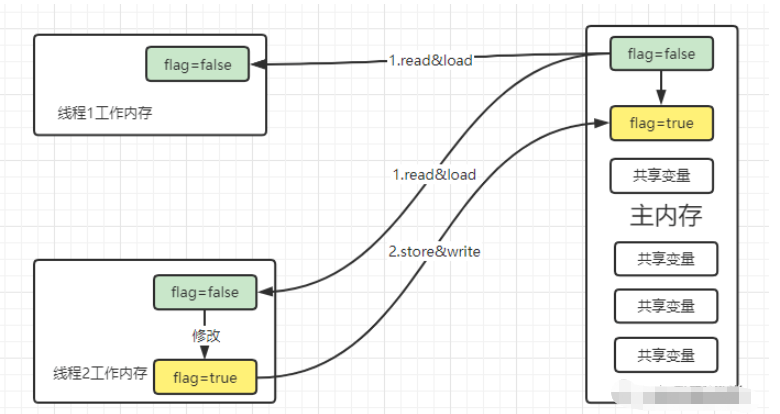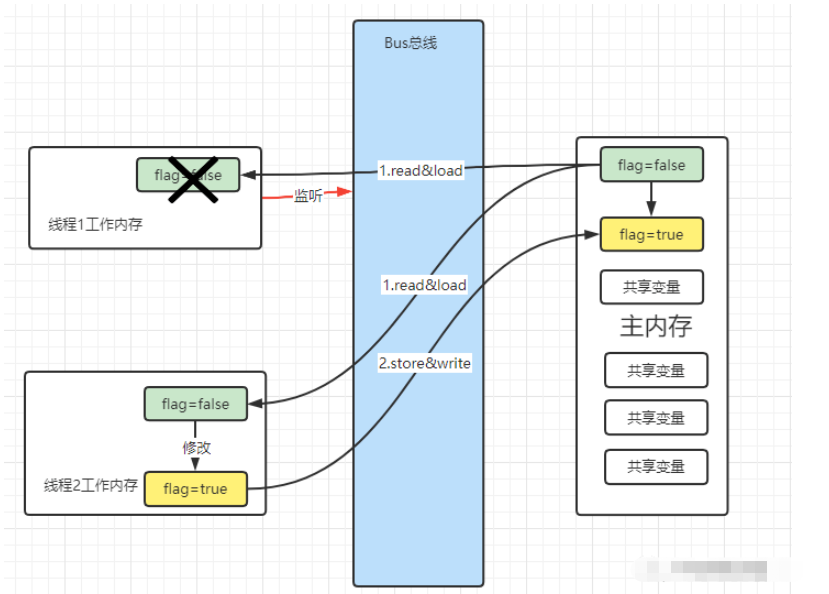 Java
Java
 javaTutorial
javaTutorial
 Example analysis of volatile and JMM multi-threaded memory model of Java concurrent programming
Example analysis of volatile and JMM multi-threaded memory model of Java concurrent programming
Example analysis of volatile and JMM multi-threaded memory model of Java concurrent programming
1. See the phenomenon through the program
Before we start to explain the Java multi-threaded cache model, let’s first look at the following code. The logic of this code is very simple: the main thread starts two sub-threads, one thread 1 and one thread 2. Thread 1 executes first, and thread 2 executes after sleeping for 2 seconds. The two threads use a shared variable shareFlag, with an initial value of false. If shareFlag is always equal to false, thread 1 will always be in an infinite loop, so we set shareFlag to true in thread 2.
public class VolatileTest {
public static boolean shareFlag = false;
public static void main(String[] args) throws InterruptedException {
new Thread(() -> {
System.out.print("开始执行线程1 =>");
while (!shareFlag){ //shareFlag = false则一直死循环
//System.out.println("shareFlag=" + shareFlag);
}
System.out.print("线程1执行完成 =>");
}).start();
Thread.sleep(2000);
new Thread(() -> {
System.out.print("开始执行线程2 =>");
shareFlag = true;
System.out.print("线程2执行完成 =>");
}).start();
}
}If you have not learned the JMM thread model, maybe after reading the above code, you hope that the output result is as follows:
Start executing thread 1 => Start executing thread 2 => Thread 2 execution is completed => Thread 1 execution is completed =>
As shown in the figure below, normal people understand this code. First execute thread 1 and enter the loop. 2 Modify shareFlag=true, and thread 1 jumps out of the loop. Therefore, thread 1 that breaks out of the loop will print "Thread 1 execution completed =>", but after the author's experiment, **"Thread 1 execution completed =>" will not be printed, and thread 1 does not break out of the infinite loop**. This Why?

2. Why does this phenomenon occur (JMM model)?
To explain the problems mentioned above, we need to learn the JMM (Java Memory Model) Java memory model. I think it is more accurate to call it Java multi-threaded memory model.

First of all, in JMM, each thread has its own working memory. When the program starts, the thread loads the shared variables (read&load) into In its own working memory, the memory variables loaded into the thread's working memory are copies of the shared variables in the main memory. That is to say, there are three copies of shareFlag in memory at this time, and their values are all equal to false.
When thread 2 executes
shareFlag=true, its working memory copy is modified toshareFlag=true, and the value of the copy is synchronized at the same time Write back (store&write) to main memory.But
shareFlag=falsein the working memory of thread 1 has not changed, so thread 1 has been in an infinite loop. middle.
3. MESI cache coherence protocol
The modification of shared variables by thread 2 will not be perceived by thread 1, which is consistent with the above experimental results and JMM model. So how can thread 1 perceive that the value of the shared variable has changed? In fact, it is very simple. Just add the volatile keyword to the shareFlag shared variable.
public volatile static boolean shareFlag = false;
The underlying principle is like this. Adding the volatile keyword prompts JMM to follow the MESI cache consistency protocol. The protocol contains the following cache usage specifications (If you don’t understand it, you can ignore it. It will be used below. Describe it in simple language and examples).
Modified: Represents that the data of the current cache line is modified (Dirty), and is only modified in the cache of the current CPU; at this time, the The data in a cache row is different from the data in other caches and different from the data in the row in memory.
Exclusive: Indicates that the data of the current Cache line is valid data, and there is no such line of data in the cache of other CPUs; and the data of the current Cache line is different from the data in the memory. same.
Shared: This line of data will be cached in the Cache representing multiple CPUs, and the data in the Cache is consistent with the data in the memory;
Invalid: Indicates that the data in the current Cache line is invalid;

The cache above The usage specification may be too complicated. To put it simply,
When thread 2 modifies shareFlag (refer to Modify), inform the bus that I have modified the shared variable shareFlag,
Thread 1 monitors the Bus. When it learns that the shared variable shareFlag has been modified, it will delete the copy of shareFlag in its working memory to render it invalid.
When thread 1 needs to use shareFlag again and finds that there is no copy of the shareFlag variable in the working memory, it will reload (read&load) from the main memory
The above is the detailed content of Example analysis of volatile and JMM multi-threaded memory model of Java concurrent programming. For more information, please follow other related articles on the PHP Chinese website!

Hot AI Tools

Undresser.AI Undress
AI-powered app for creating realistic nude photos

AI Clothes Remover
Online AI tool for removing clothes from photos.

Undress AI Tool
Undress images for free

Clothoff.io
AI clothes remover

Video Face Swap
Swap faces in any video effortlessly with our completely free AI face swap tool!

Hot Article

Hot Tools

Notepad++7.3.1
Easy-to-use and free code editor

SublimeText3 Chinese version
Chinese version, very easy to use

Zend Studio 13.0.1
Powerful PHP integrated development environment

Dreamweaver CS6
Visual web development tools

SublimeText3 Mac version
God-level code editing software (SublimeText3)

Hot Topics
 1386
1386
 52
52
 Perfect Number in Java
Aug 30, 2024 pm 04:28 PM
Perfect Number in Java
Aug 30, 2024 pm 04:28 PM
Guide to Perfect Number in Java. Here we discuss the Definition, How to check Perfect number in Java?, examples with code implementation.
 Weka in Java
Aug 30, 2024 pm 04:28 PM
Weka in Java
Aug 30, 2024 pm 04:28 PM
Guide to Weka in Java. Here we discuss the Introduction, how to use weka java, the type of platform, and advantages with examples.
 Smith Number in Java
Aug 30, 2024 pm 04:28 PM
Smith Number in Java
Aug 30, 2024 pm 04:28 PM
Guide to Smith Number in Java. Here we discuss the Definition, How to check smith number in Java? example with code implementation.
 Java Spring Interview Questions
Aug 30, 2024 pm 04:29 PM
Java Spring Interview Questions
Aug 30, 2024 pm 04:29 PM
In this article, we have kept the most asked Java Spring Interview Questions with their detailed answers. So that you can crack the interview.
 Break or return from Java 8 stream forEach?
Feb 07, 2025 pm 12:09 PM
Break or return from Java 8 stream forEach?
Feb 07, 2025 pm 12:09 PM
Java 8 introduces the Stream API, providing a powerful and expressive way to process data collections. However, a common question when using Stream is: How to break or return from a forEach operation? Traditional loops allow for early interruption or return, but Stream's forEach method does not directly support this method. This article will explain the reasons and explore alternative methods for implementing premature termination in Stream processing systems. Further reading: Java Stream API improvements Understand Stream forEach The forEach method is a terminal operation that performs one operation on each element in the Stream. Its design intention is
 TimeStamp to Date in Java
Aug 30, 2024 pm 04:28 PM
TimeStamp to Date in Java
Aug 30, 2024 pm 04:28 PM
Guide to TimeStamp to Date in Java. Here we also discuss the introduction and how to convert timestamp to date in java along with examples.
 Java Program to Find the Volume of Capsule
Feb 07, 2025 am 11:37 AM
Java Program to Find the Volume of Capsule
Feb 07, 2025 am 11:37 AM
Capsules are three-dimensional geometric figures, composed of a cylinder and a hemisphere at both ends. The volume of the capsule can be calculated by adding the volume of the cylinder and the volume of the hemisphere at both ends. This tutorial will discuss how to calculate the volume of a given capsule in Java using different methods. Capsule volume formula The formula for capsule volume is as follows: Capsule volume = Cylindrical volume Volume Two hemisphere volume in, r: The radius of the hemisphere. h: The height of the cylinder (excluding the hemisphere). Example 1 enter Radius = 5 units Height = 10 units Output Volume = 1570.8 cubic units explain Calculate volume using formula: Volume = π × r2 × h (4
 Create the Future: Java Programming for Absolute Beginners
Oct 13, 2024 pm 01:32 PM
Create the Future: Java Programming for Absolute Beginners
Oct 13, 2024 pm 01:32 PM
Java is a popular programming language that can be learned by both beginners and experienced developers. This tutorial starts with basic concepts and progresses through advanced topics. After installing the Java Development Kit, you can practice programming by creating a simple "Hello, World!" program. After you understand the code, use the command prompt to compile and run the program, and "Hello, World!" will be output on the console. Learning Java starts your programming journey, and as your mastery deepens, you can create more complex applications.



